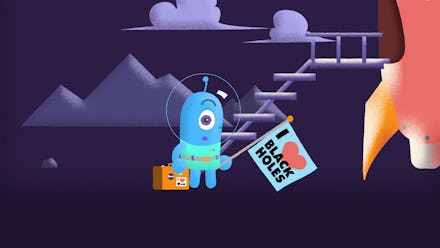WTF is 'spaghettification'? NASA's adorable black hole safety video explains

When it comes to black holes, NASA is doing its due diligence to make sure everyone knows a little bit more about these enigmas of space – specifically, the dangers of getting too closed to one and turned into a giant human noodle. Created in celebration of NASA's Black Hole Week (yes, that's very much a thing), this oddly cute little clip features cartoony monsters learning the basics of black hole science. If you're allergic to realistic scientific portrayals, this video should capture your attention much more readily.
For one, the video warns, you should definitely not take a vacation to a black hole or spend any time around one. The alien in the video is understandably a bit sad about this, but hey, at least it can retain its vaguely human-like shape.
What is a black hole, anyway? It's actually not a hole, a portal to another dimension, and not a "vacuum," as the video reminds us. Its textbook definition is that it's a "region of space having a gravitational field so intense that no matter or radiation can escape." NASA's explanation for younger space fans says it best: it's a "place in space" where gravity is pulling so much that nothing, not even light, is capable of getting out. Because of this, black holes are actually invisible, though powerful space telescopes are capable of finding them with a variety of tools that can detect them.
Interestingly enough, the first picture of a black hole was just captured this year in April, thanks to a network of telescopes called the Event Horizon Telescope. The light emitted by the black holes' disks of gas and other material it's "sucked in" essentially allowed scientists to get a picture of it.
But as large as they seem, black holes are not always huge, menacing spots in space. They can be large or small, and scientists believe there are some as tiny as the size of an atom. No matter the size, all black holes possess a ridiculous amount of mass, or the amount of matter in the object. There are "supermassive" black holes, which are extremely large, or even "stellar" black holes, with mass of up to 20 times more than the sun. NASA's video does a good job of giving you a rundown of what a black hole actually is, without getting too far into the weeds.
The nearest black hole to Earth is 3,000 light years away, but if they're invisible, how can we even point one out? Well, that's basically a case of inspecting things that orbit around them. For instance, black holes might be found when stars appear to orbit around nothing, meaning you see "glowing stuff" surrounding the area where a planet might be. That's one good indicator, according to NASA. But as the video points out, it's much too dangerous to get too close to see, which obviously makes studying them difficult.
The closer you get to a black hole, the deadlier the radiation around it becomes. There's even "gravitational time dilation" that occurs around the object — i.e. clocks might appear to tick more slowly than those found further away from the black hole. If the gravitational weirdness and time dilation doesn't terrify you though, the whole concept of "spaghettification" and being turned into a "noodle" is pretty creepy too. Imagine that – your entire body being long and stretched out like a noodle due to the intense gravitational pull. That's what many astrophysicists believe happens to any object that gets caught in a black hole.
The bottom line here from this adorable and fun educational video? Black holes are nothing to mess with. So the next time you're staring at the news cycle wondering about the feasibility of shooting yourself into space, thinking you might zip over and visit a black hole, you'll know to keep an eye out for any strange happenings or stars orbiting around nothing...and then stay away.